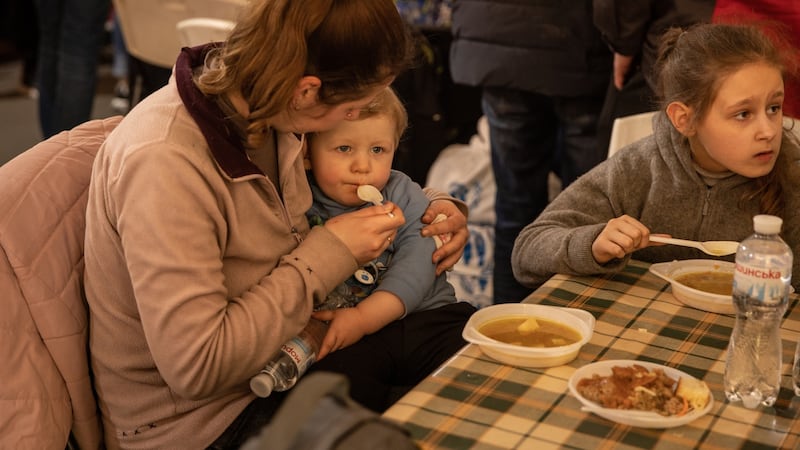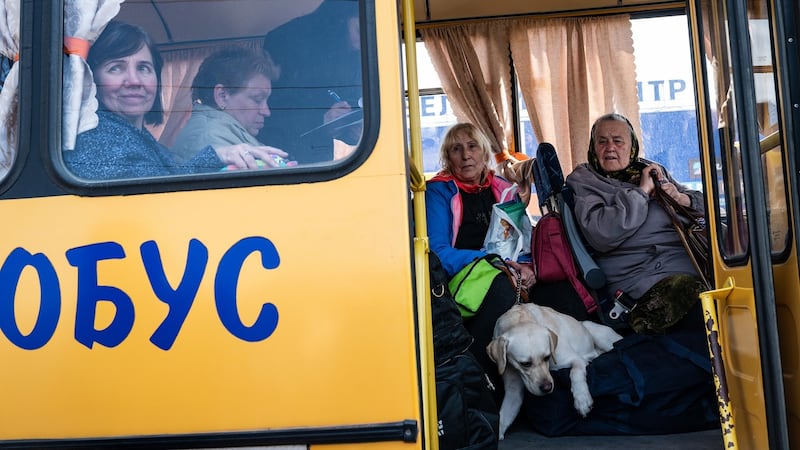Some flashed bright smiles and others bent over in heaving sobs, sharing the end of their hellish subterranean ordeal. Here, at last, were ordinary things they thought they might not live to see again: sunlight, enough food and escape from incessant Russian shelling.
On a fleet of city buses, flanked by white United Nations and Red Cross vehicles, nearly 130 women, children and elderly people on Tuesday reached the relative safety of Ukrainian-controlled territory, after weeks huddled in the belly of Mariupol's sprawling steelworks.
They had sheltered in the near-darkness of underground bunkers, with little food or water as explosives of all shapes and sizes rained down day and night, slowly chipping away the steel and concrete overhead that was their only protection. "For some reason I remember Easter, Easter Day, " said Inna Papush, who spent 58 days underground with her daughter, Dasha (17). "We thought it would be a holy day and they would take a break," she said of the Russian forces. "But the shelling became even heavier," Dasha Papush said, completing her mother's thought. Western leaders pressed harder on Tuesday to arm Ukraine, hinder the Kremlin and strengthen the Nato alliance – US president Joe Biden visited a factory that makes anti-tank missiles that have been vital to the Ukrainian cause – even as Russian president Vladimir Putin of Russia warned that they were only making matters worse.
And in the parking lot of the Epicenter shopping complex in Zaporizhzhia, in southeastern Ukraine, evacuees from Mariupol stepped from buses, blinking in the sunshine. They were greeted by a parade of aid workers offering tea and snacks and a less-than-quiet place to rest in a large white tent buzzing with journalists, psychologists and the occasional politician. Children were given candy, while an air raid siren sounded briefly, ignored by all.
Their evacuation was a rare but limited victory for diplomacy, and an unusual concession to human dignity by Russian forces who have inflicted death and misery upon civilian populations across a broad swathe of Ukraine since the war began on February 24th.

Negotiators from the UN and the International Committee for the Red Cross brokered a deal with the Russians that allowed for the civilians to escape the Azovstal steel plant, the sprawling complex that had been their refuge. But it came only after more than two months of intense attacks that have turned Mariupol, once a vivacious port city, into a ruin of bomb-blasted buildings. In addition to 127 evacuees who fled to Zaporizhzhia, about 30 escaped the plant but chose to remain in Mariupol, according to the Associated Press.
In the days leading up to a ceasefire that allowed the civilians to escape, Russian forces escalated their attacks on the plant, causing cave-ins that hampered rescue efforts and killing and injuring unknown numbers, according to Ukrainian officials and troops who are still there.
"I was in Azovstal for 2½ months and they slammed us from all sides," said Olga Savina, an elderly woman, as she emerged from a white city bus provided by Zaporizhzhia authorities for the evacuation. As she spoke, she repeatedly cast her gaze down to the pavement, explaining that the sun burned her eyes after so many days underground.
From the evacuees a picture began to emerge of life in Azovstal. The steel mill was like a small city, with roads and buildings dating to the era after the second World War, when any big Soviet construction project included reinforced bomb shelters equipped with everything needed for long-term survival.

Evacuees described bunkers, most housing 30 to 50 people, with kitchens, bathhouses and sleeping areas. The shelters were spread out around the grounds of the complex, so there was little contact between groups hiding in different places. There in the dark, a semblance of day-to-day life took shape. “We got used to it being very dark. We had to economise food,” said Dasha Papush. “The soldiers brought us what they could: water, food, oatmeal.” “We didn’t eat like we did at home,” she added.
It was just always, boom, boom, boom, boom. It was a real strain on the brain
Many of the evacuees had been underground since the earliest days of the war. For a woman named Anna (29) who placated her young son, Ivan, with a lollipop, it was 57 days. While there, she was separated from her husband, a fighter in the National Guard, by a brisk, 15-minute walk through the factory ruins, although visits were rare because of the shelling and constant fighting.
Leaving the safety of the underground shelter was treacherous, but necessary for survival. "The guys who are with us went out under fire and tried to find us a generator and fuel, so that we had electricity to charge our flashlights," she said. "We of course had to search for water." For Sergei Tsybulchenko (60) the reason to emerge was firewood. Scattered around the grounds of the factory were shipping palettes that he and a few men would collect and break up to fuel the cooking fire that he and his fellow inmates had made in a part of their bunker. He and the 50 or so others crammed into his bunker would gather to prepare and share one meal a day, he explained – usually a mix of macaroni, oatmeal and canned meat, cooked all together in a large pot.
Tsybulchenko said the fire had to be kept low, for fear that it could be detected by thermal sensors on Russian jets. "It was just always, boom, boom, boom, boom," he said. "It was a real strain on the brain." Under constant bombardment, he said, the shelter began to disintegrate, with a portion of it collapsing. Over the weekend, for the first time in weeks, it stopped. In Tsybulchenko's shelter, three soldiers with the Azov regiment, a Ukrainian military unit whose soldiers make up the bulk of those fighting at Azovstal, asked for anyone suffering from any illnesses to come forward. Tsybulchenko's wife, Nelya, who has asthma, raised her hand. The couple walked out of the shelter into the sunlight with their daughter, her husband and a small dog.
Only 11 people from their bunker were chosen to leave, leaving some 40 others behind. Those who remained included a mother with her two children, who Tsybulchenko said was scared to leave because her husband was a high-ranking officer fighting at the plant.
“She was worried that if they found out, she would end up in a prison camp together with the children,” he said.

The mayor of Mariupol, Vadym Boichenko, said in a televised interview on Tuesday that more than 200 civilians were still hiding at the plant, and that more than 100,000 people remained scattered about the city. Inside Azovstal, supplies of food, water and medicines have dwindled to critical levels.
It took Tsybulchenko and his family nearly two hours just to make it out of the complex. An elderly man who was with them had to be carried over twisted equipment, through massive craters and around unexploded ordnance. Once outside, the evacuees were handed over to Russian troops and eventually put on buses for what would become a three-day, roundabout journey through dozens of checkpoints, where Russian soldiers fingerprinted and photographed them and interrogated them about the locations of Ukrainian fighters still at the plant.
At one point on the journey, Tsybulchenko looked off in the distance and saw the remains of Mariupol, the city of his birth. The apartment that his grandfather had received from Soviet authorities in the 1960s and where he had lived since he was three years old was gone. On the horizon, he could make out the jagged shapes of the steel factory.
"A black smoke hung over Azovstal," he said. – This article originally appeared in the New York Times











